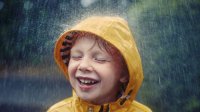Rainstorms and Symphonies: Performing Arts Bring Abstract Concepts to Life
When early elementary teachers integrate music and theater, student learning improves in reading, math, and science as they become better critical thinkers and problem solvers.
Your content has been saved!
Go to My Saved Content.Clouds are floating,
Clouds are floating,
All around,
All around.
In an early childhood classroom in Maryland, the classic children's song "Frere Jacques" is transformed into an active lesson about predicting weather patterns. As a group of active children sing, they move their bodies around like floating clouds, making their arms big like balloons as they fill up first with air, then with water. When they become too full with water droplets, they mimic falling rain with their fingers, make the sounds of thunder with their mouths, and move their bodies limply as empty clouds. Through music and movement -- as musicians and actors -- the children don't just learn about rain, they engage their imaginations and embody the water cycle. This lesson is arts integration at work.
We created the rainstorm experience together last year as partners in an arts-integrated classroom residency through the Wolf Trap Institute for Early Learning Through the Arts, in which preschool and kindergarten teachers and Wolf Trap-trained teaching artists pair up for hands-on professional development. Arts integration uses singing, dancing, and other elements of the performing arts to engage young children in more active classroom experiences and inspire learning through all of their senses. When students are exposed to arts-integrated teaching, Wolf Trap has found that learning improves across subject areas, including reading, math, and science, as they become better critical thinkers and problem solvers. In fact, the Institute recently participated in an independent American Institutes of Research study that showed how, in the classrooms of Wolf Trap-trained teachers participating in a model STEM-focused program, students gained the equivalent of more than a month's additional math learning.
Sensory and Experiential Learning
For us, working together to incorporate the performing arts (primarily music and drama) into instruction helped hesitant or disinterested students get more involved in daily lessons. The classroom became exciting and dynamic, and the children began to make stronger connections between concrete and abstract concepts, like rain and the water cycle. As any educator of young children knows, abstract thinking is one of the most difficult cognitive skills to teach. In two distinct lessons about water, though, we successfully used music and drama to bring abstract ideas to life.
Rainstorms: Music is one of many ways in which the arts can help younger students focus and develop a fluency in learning. It's also a tool that we used often in our collaboration as classroom teacher and teaching artist. To create a meaningful lesson about rain, for example, we played an excerpt of Haydn's "Surprise Symphony." As the students listened, we asked them to tap a set of sticks to the beat whenever they heard music that sounded like rain. If they heard thunder, we told them to raise their sticks. Through the musical concepts of steady beat and dynamics, they connected their concrete understanding of a rainstorm to an abstract representation of weather in a piece of music. After the lesson, we noticed that some students would start to tap on their legs when they talked about rain, or portray what they saw happening outside through body movement.
Water Conservation: One of the most effective lessons that we designed together introduced the abstract concept of water conservation through a role-playing exercise about animals at a watering hole. We used a technique called "coffee can theater," in which we introduce small props from a container to represent characters, setting, and plot that students then use to retell key elements of a story. As the narrative unfolded, the imaginary watering hole got smaller and smaller, until there was no water left for the animals to drink. The students were confronted with a concrete problem that they had to discuss as a group. What would happen next? How could we make sure that the animals had water to drink? The students connected the water shortage with the meaning of conservation, and applied the lesson to their own lives by placing a bucket underneath the faucet in our classroom to monitor how much water they used to wash hands and brush teeth. They went as far as creating competitions to see which group used the least.
Understanding Through Art
Throughout this experience, we worked side by side to find new ways of integrating the arts into planned lessons and engaging the children in more active and meaningful learning experiences. Through our collaborative effort, our students were able to develop new understanding through an art form, and also cultivate their own creative skills and expression.
The performing arts offer a powerful way to connect students with many different learning styles, and they can be especially effective in helping children experience the joy of being artists while learning essential skills for the future. When the arts are integrated into instruction, students begin by constructing understanding through an art form. Teachers and artists enrich what students learn, teaching them how to demonstrate what they know through music, drama, singing, and dancing. The beauty of arts integration is how the knowledge and creativity turn into a cycle of their own -- not only do the students internalize the content, but the content also serves as the vehicle for them to become artists. That's when we saw students' faces lighting up, and it was the moment when we knew that arts integration had transformed the way they learn.
